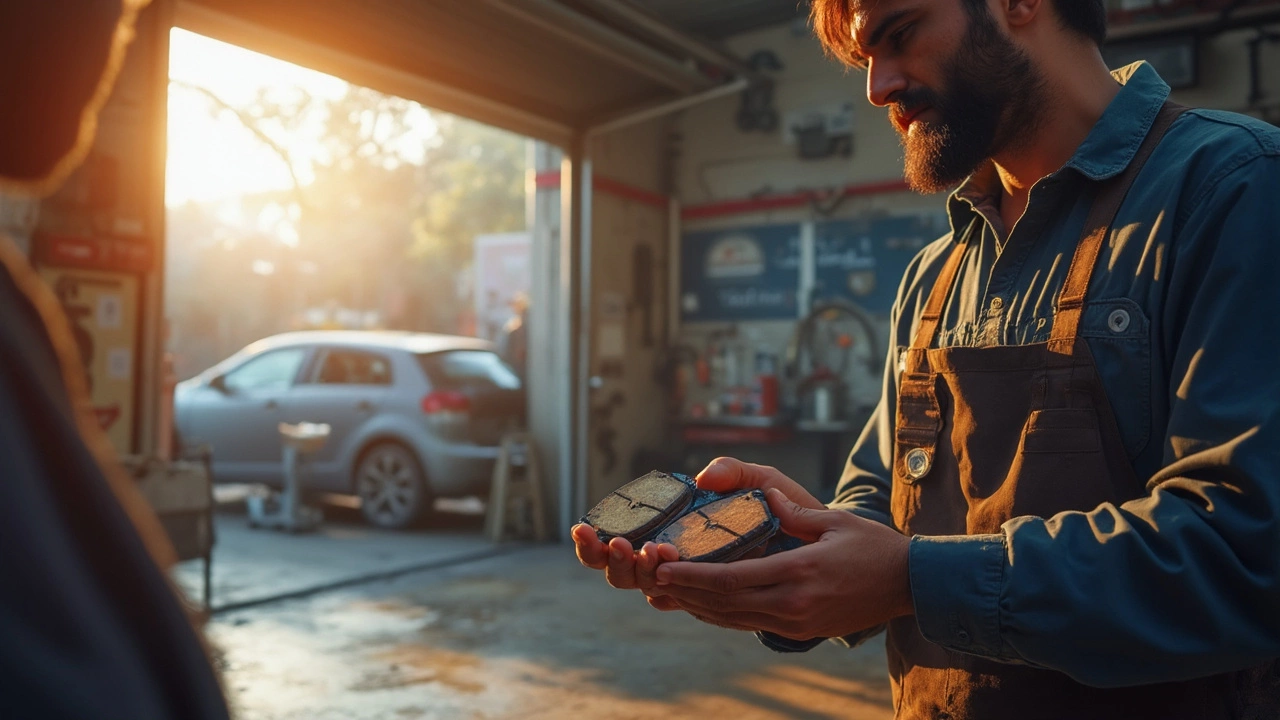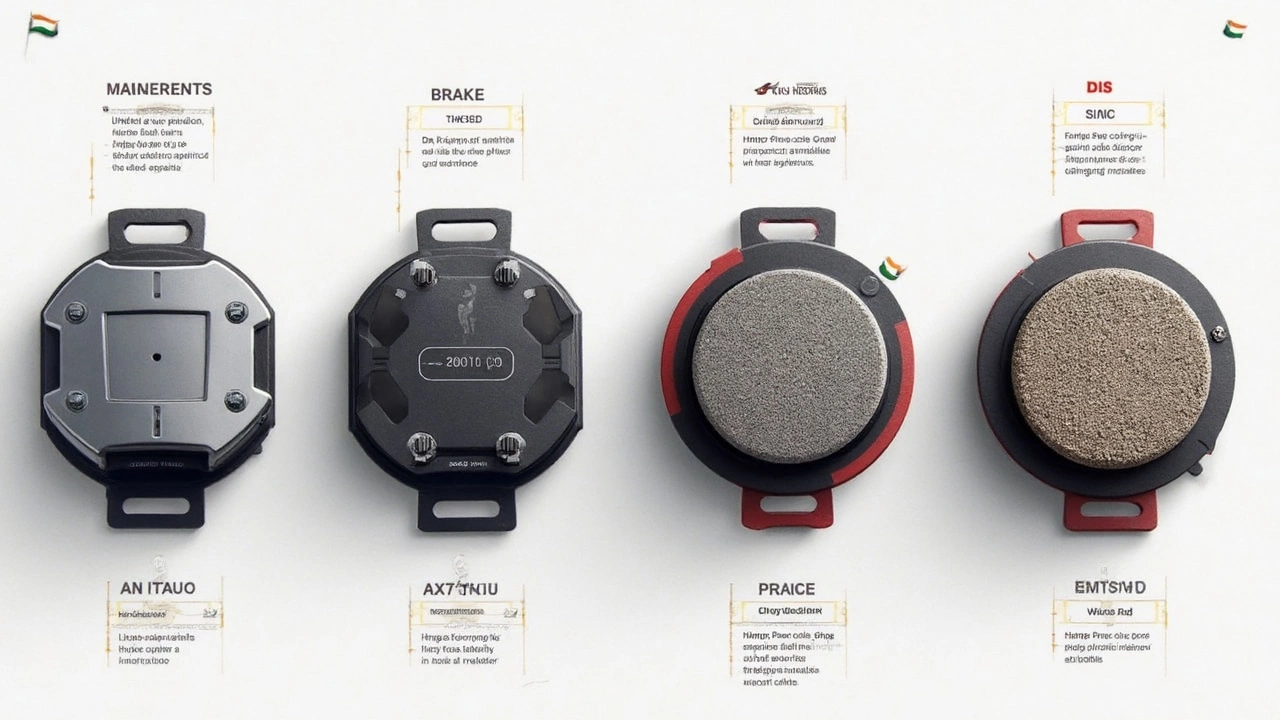 Apr, 16 2025
Apr, 16 2025
So, you've probably wondered at some point: should I really stash away two sets of brake pads? Seems like a wild idea, right? But in the world of car maintenance, it's not as bonkers as it sounds. Let's break it down.
First off, brakes are like the unsung heroes of your car. They don't get a lot of love until something goes wrong. One of the simplest ways to avoid nasty surprises is understanding how your brake pads wear out. Most folks drive until they hear that annoying squeal, but that noise means you're way past due for a swap. Keeping tabs on your brake pads' condition can't be overstated.
- Understanding Brake Pad Wear
- When to Replace Brake Pads
- Advantages of Having a Spare Set
- Types of Brake Pads
- Driving Habits and Brake Pad Longevity
Understanding Brake Pad Wear
Alright, so let’s get down to business with brake pad wear. They’re not just essential; they’re your car’s best buddy on the road. Brake pads work by creating friction, slowing your wheels when you press the brake pedal. But here's the thing—they're not immortal. Over time, that friction causes them to lose material, like a pencil getting shorter as you sharpen it.
Now, how quickly your brake pads wear out depends on several things. Your driving style? Huge factor. Frequent stop-and-go driving or aggressive braking can chew through brake pads faster than a hot knife through butter. On the flip side, if you’re mostly on highways, your pads might last longer.
Another aspect is the weight of your vehicle. Heavier cars or carrying lots of stuff puts more pressure on the pads. This makes them wear out faster compared to lighter loads.
The material of the brake pad is crucial, too. Most pads are made from semi-metallic, organic, or ceramic materials. Each type has its own pros and cons in terms of performance, noise, and longevity.
It's also key to keep an ear out for that tell-tale squeal. Most brake pads come with a built-in wear indicator that lets out a screeching sound when they’re getting thin. Annoying? Yes. But it’s a smart way to know it’s time for new pads before things get dicey.
Check out this simple stat: on average, brake pads last between 30,000 and 70,000 miles, depending on all those factors we just talked about. Keeping an eye on your brake pads’ condition is not just about avoiding that nails-on-chalkboard sound; it’s about owning a safe-driving plan.
When to Replace Brake Pads
Ever wondered when you really need to swap out those brake pads? Trust me, you're not alone. Understanding when to replace your brake pads can save you a heap of trouble and keep you safe on the road.
First, let's talk about the warning signs. If you hear a high-pitched screeching when you hit the brakes, that's your car basically yelling at you to change the pads. Manufacturers often add a little metal shim, aka an indicator, that gives off that noise when pads get too thin. If you hear it, don't ignore it.
How often should you check your pads? A good rule of thumb is every 10,000 miles. For most cars, the average lifespan of brake pads is about 30,000 to 70,000 miles. But this depends on your driving style and conditions. Frequent city driving with lots of starting and stopping? You might burn through them faster.
If you're more visually inclined, pop off your wheel (if you're comfortable doing so) and look. If there's less than a quarter-inch of pad, it's time to replace. Also, if your car's pulling to one side or if you feel a vibration in the pedal, that's a call for a brake check too.
- Driving habits: Aggressive braking wears pads out faster.
- Environment: Mountains and city driving affect pad wear.
- Pad material: Organic pads wear quicker than carbon-based ones, but might be more suited for less aggressive driving styles.
Want some numbers? Sure! Here's a table showing possible pad lifespan based on different conditions:
| Condition | Possible Lifespan |
|---|---|
| Highway Driving | Up to 70,000 miles |
| City Driving | 30,000 - 50,000 miles |
| Aggressive Driving | Less than 30,000 miles |
Regular checks and a little attention can help you avoid last-minute scrambles for replacements or, worse, more serious brake system issues. Stay ahead of it, and your car will be in top shape.

Advantages of Having a Spare Set
Ever been caught out with a car issue at the worst possible moment? Yeah, it's a massive pain. The same goes for brake pads. Having a spare set handy can save a ton of headaches. Let's get into why it might be smart to keep extras around.
First up, there’s the element of surprise. Brake pads don’t like to give a heads-up before wearing out. By stashing a spare set, you avoid those annoying last-minute trips to the auto shop, and it cuts down on the downtime. You know, when your car's stuck in the garage waiting for those pads to arrive?
Another bonus? Cost savings. Cars always seem to demand cash when it's least convenient, right? When you buy brake pads in pairs during sales or bundle offers, you often score a better deal, saving money in the long run. Plus, keeping an eye on those sales means you're not caught off guard by brake issues and forced to pay whatever the going rate is.
Plus, if you're the type who loves road trips or off-roading adventures, having that spare set could be a lifesaver. Imagine you're miles from the nearest town, and the only thing separating you from continuing your awesome adventure is a worn-out brake pad.
- Convenience: No more sudden stops at auto repair places.
- Cost-effective: Buy when prices are low and stock up.
- Prepared for the unexpected: Prefer snugly evenings at home over impromptu mechanic visits.
- Peace of mind: Knowing you're ready for any brake hiccup at a moment's notice.
Types of Brake Pads
Alright, let's get into the nitty-gritty of brake pads. Not all brake pads are created equal, and understanding the different types can help you make smarter decisions for your car's needs. The main types are ceramic, organic, and semi-metallic. Each has its perks and quirks, so let's break them down.
Ceramic brake pads are the golden child for regular street driving. They're made from a mix of ceramic fibers and filler materials, making them quieter and less dusty than others. Plus, they last a good while. Perfect if you're hopping around town or on the highway more than hitting dirt roads.
Now, if you're all about that old-school vibe, organic brake pads are your jam. They're made from natural materials like glass, rubber, or Kevlar. They're super eco-friendly, which is neat. They’re also pretty quiet and gentle on the rotors, but don’t last as long as ceramics.
When it comes to some serious stopping power, that's where semi-metallic brake pads shine. Made from a blend of metal shavings, they handle heat better and provide excellent braking. Are you driving in wintery conditions or doing some spirited driving? Then semi-metallic pads might be your best bet.
Now, here's a handy comparison of each type:
| Type | Durability | Noise Level | Price |
|---|---|---|---|
| Ceramic | High | Low | High |
| Organic | Low | Low | Low |
| Semi-Metallic | Medium | High | Medium |
So, which type should you pick? Well, think about your driving habits and your car's demands. If you're a city dweller, ceramics might be your best choice. Off-roading enthusiast? Semi-metallics could suit you. It's all about aligning with your lifestyle and car's performance needs.

Driving Habits and Brake Pad Longevity
Alright, let’s get real about how the way you drive affects your brake pads. Ever heard the saying, 'Drive it like you stole it'? Well, fun as that sounds, it’s brutal on your brake pads. Fast starts and hard stops are like the worst kind of stress test for them.
If you’re zipping through traffic, riding the brake in stop-and-go conditions, your brake pads are in for a tougher ride. Over time, this aggressive style leads to quicker wear, meaning you might be in the market for not one, but two sets of brake pads sooner than you'd like.
On a different note, those chilling in the slow lane with gentle pressures on the brake pedal? Congrats, your pads are thanking you. Softer braking and a mindful approach will definitely stretch out the lifespan of your brake pads. It's the little things, like coasting to slow down rather than slamming the brakes.
"How you drive has more impact on brake pad life than you might think," says Dave Smith, a veteran auto mechanic. "Think of braking like running: the harder you slam, the faster you tire out."
Also, consider the weight your vehicle's hauling. A car loaded with gear for a cross-country road trip is gonna need more stopping power than one just carrying you and a coffee. The trick is understanding how this added weight affects brake performance and longevity.
To wrap things up, here’s a quick tip: make friends with cruise control. Using it on highways helps maintain a steady speed, reducing the frequency of braking. In the end, being mindful of your driving habits not only keeps your car in good shape but also saves you from emptying your wallet on brake replacement costs.